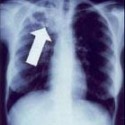30 Mar Diagnosing TB in Children: Evaluating Xpert Assay

Tuberculosis creates cavities visible in x-rays like this one in the patient’s right upper lobe Wikipedia
MedicalResearch.com Interview with:
Dr Anne K Detjen, MD
Child Lung Health Consultant
International Union Against Tuberculosis and Lung Disease
Medical Research: What is the background for this study? What are the main findings?
Dr. Detjen: The bacteriological diagnosis of tuberculosis (TB) in children is challenging due to the difficulty in obtaining specimens such as sputum and the lack of an accurate and accessible diagnostic test. In most cases, diagnosis is made on clinical grounds based on a contact history and a combination of signs and symptoms. We included 15 studies in a systematic review and meta-analysis of Xpert for the diagnosis of pulmonary TB in children.
The accuracy of Xpert for diagnosing TB in children is suboptimal, and the majority of children will still have to be diagnosed clinically. However, in settings where it replaces smear microscopy Xpert will increase the likelihood of bacteriological confirmation of TB as well as MDR TB among children. Xpert does not increase the number of confirmed TB cases among culture-negative children. We also found that smear status highly impacted Xpert results, i.e. a higher yield among smear positive compared to smear negative children. Smear positivity increases with bacillary load and might be a proxy for disease severity. Unfortunately, we were not able to assess the performance among children with different stages of disease severity since this was not classified in any of the studies included.
Medical Research: What should clinicians and patients take away from your report?
Dr. Detjen: Access to Xpert will increase the likelihood of confirming TB in children in settings where it replaces smear microscopy. At the same time, it will increase diagnosis of MDR TB among children. If available, Xpert should be used as part of the diagnostic workup among children with presumed TB. However, Xpert cannot be used as a rule-out test. The sensitivity of Xpert is suboptimal and a negative test does not exclude TB. In order to improve diagnostic yield it is important to collect quality specimens from children, either expectorated sputum (in older children), induced sputum or gastric fluids. Training of health care workers in specimen collection is crucial to optimize the use of Xpert. Results have to be interpreted in the context of other signs and symptoms including contact history and severity of disease.
Medical Research: What recommendations do you have for future research as a result of this study?
Dr. Detjen: Future research should address the performance of Xpert in children managed at different levels of the health care system (in- versus outpatients, higher-level versus secondary and primary level of care) as well as its performance in children with different stages of disease severity. These data are urgently needed to inform the scale-up of Xpert into routine programmes. Routine data should be collected and analyzed, including the impact of Xpert on empiric treatment and treatment outcomes among children.
Citation:
The Lancet Respiratory Medicine Published Online: 23 March 2015
DOI: http://dx.doi.org/10.1016/S2213-2600(15)00095-8
MedicalResearch.com Interview with: Dr Anne K Detjen, MD (2015). Diagnosing TB in Children: Evaluating Xpert Assay
Last Updated on March 30, 2015 by Marie Benz MD FAAD
